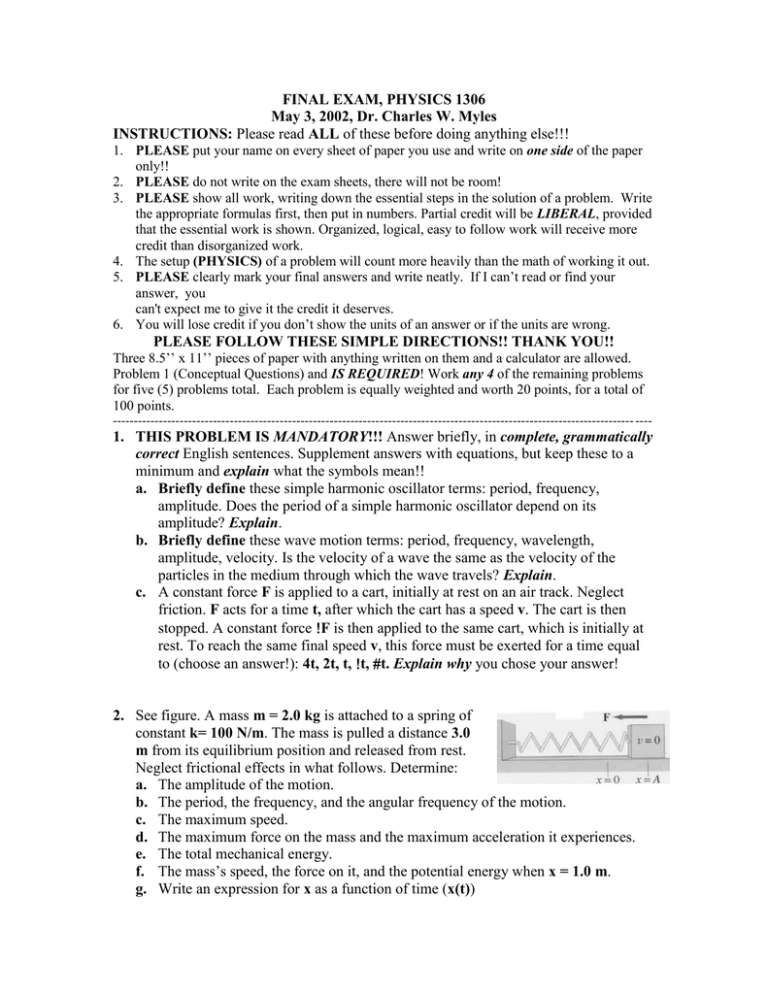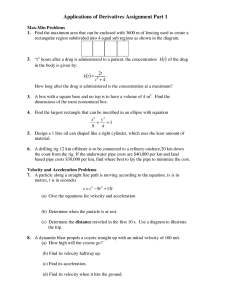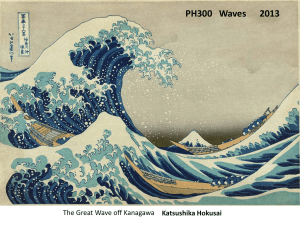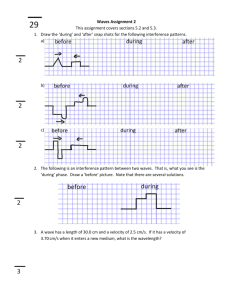FINAL EXAM, PHYSICS 1306 May 3, 2002, Dr. Charles W. Myles INSTRUCTIONS:
advertisement

FINAL EXAM, PHYSICS 1306 May 3, 2002, Dr. Charles W. Myles INSTRUCTIONS: Please read ALL of these before doing anything else!!! 1. PLEASE put your name on every sheet of paper you use and write on one side of the paper only!! 2. PLEASE do not write on the exam sheets, there will not be room! 3. PLEASE show all work, writing down the essential steps in the solution of a problem. Write the appropriate formulas first, then put in numbers. Partial credit will be LIBERAL, provided that the essential work is shown. Organized, logical, easy to follow work will receive more credit than disorganized work. 4. The setup (PHYSICS) of a problem will count more heavily than the math of working it out. 5. PLEASE clearly mark your final answers and write neatly. If I can’t read or find your answer, you can't expect me to give it the credit it deserves. 6. You will lose credit if you don’t show the units of an answer or if the units are wrong. PLEASE FOLLOW THESE SIMPLE DIRECTIONS!! THANK YOU!! Three 8.5’’ x 11’’ pieces of paper with anything written on them and a calculator are allowed. Problem 1 (Conceptual Questions) and IS REQUIRED! Work any 4 of the remaining problems for five (5) problems total. Each problem is equally weighted and worth 20 points, for a total of 100 points. ----------------------------------------------------------------------------------------------------------------------------- ---- 1. THIS PROBLEM IS MANDATORY!!! Answer briefly, in complete, grammatically correct English sentences. Supplement answers with equations, but keep these to a minimum and explain what the symbols mean!! a. Briefly define these simple harmonic oscillator terms: period, frequency, amplitude. Does the period of a simple harmonic oscillator depend on its amplitude? Explain. b. Briefly define these wave motion terms: period, frequency, wavelength, amplitude, velocity. Is the velocity of a wave the same as the velocity of the particles in the medium through which the wave travels? Explain. c. A constant force F is applied to a cart, initially at rest on an air track. Neglect friction. F acts for a time t, after which the cart has a speed v. The cart is then stopped. A constant force F is then applied to the same cart, which is initially at rest. To reach the same final speed v, this force must be exerted for a time equal to (choose an answer!): 4t, 2t, t, t, t. Explain why you chose your answer! 2. See figure. A mass m = 2.0 kg is attached to a spring of constant k= 100 N/m. The mass is pulled a distance 3.0 m from its equilibrium position and released from rest. Neglect frictional effects in what follows. Determine: a. The amplitude of the motion. b. The period, the frequency, and the angular frequency of the motion. c. The maximum speed. d. The maximum force on the mass and the maximum acceleration it experiences. e. The total mechanical energy. f. The mass’s speed, the force on it, and the potential energy when x = 1.0 m. g. Write an expression for x as a function of time (x(t)) NOTE: WORK ANY FOUR (4) OF PROBLEMS 2., 3., 4., 5., 6., or 7..!!!!! 3. A cord has mass m = 0.5 kg and length L = 5 m. For parts a and b, a transverse traveling wave is set up in the cord, as in the figure. The wave velocity is v = 32 m/s. a. What is the tension in the cord? b. If the wave frequency is f = 200 Hz, what is the wavelength? In c, d, & e, the ends of the same cord as in a & b are tied to supports and a standing wave is set up by plucking the cord. (See figure). The cord has the same length & wave velocity as in a & b. Otherwise, c & d are independent of a & b. c. What is the longest possible wavelength (the fundamental) of this standing wave? What is the fundamental frequency of this cord? d. Compute the frequencies and wavelengths of the 2nd, 3rd, and 4th harmonics. 4. The following problems are independent of each other. a. Humans can detect a difference in sound intensity level of 2.0 dB. Compute the ratio of the intensities of two sounds whose levels differ by this amount. b. The intensity of a sound wave is tripled. By how many dB will the intensity level increase? In answering c and d, assume that the velocity of sound in air is v = 343 m/s. c. Find the length L of an open pipe with a fundamental frequency f1 = 300 Hz. What is the corresponding wavelength? Calculate the frequencies & wavelengths of the 2nd & 3rd harmonics. d. A pipe which is closed at one end (& open at the other!) has length L = 1.0 m. Calculate the fundamental wavelength and frequency. Calculate the wavelengths and frequencies of the first two (non-zero) harmonics. e. A narrow pipe of length L = 1.8 m is open at both ends. It is filled with a gas which is NOT air. It resonates at two successive harmonics of frequencies 275 Hz and 330 Hz. What is the speed of sound in the gas in the tube? 5. See figure. A block of mass m = 10 kg is pulled across a table by a massless cord, to which is applied a force FP = 40 N, as shown. The cord makes an angle of 30with the horizontal. The mass remains on the horizontal surface; there is no vertical motion. There is friction; the coefficient of kinetic friction between the mass and the table is k = 0.25. a. Draw the free body diagram for the mass, properly labeling all forces. b. Compute the horizontal and vertical components of the applied force FP. c. What is the normal force between the mass and the horizontal surface? (NOTE: I will give ZERO credit if you tell me that the answer is equal to the weight!) d. Compute the frictional force between the mass and the table. e. What is the acceleration of the system? f. If the mass starts from rest, what are its velocity and kinetic energy after 5 s? How much work is done by the force FP in that time? NOTE: WORK ANY FOUR (4) OF PROBLEMS 2., 3., 4., 5., 6., or 7.!!!!! 6. Note: Parts a, b, c are independent of parts d, e, f. For parts a, b, c, see figure to right. A balloon of volume V = 2000 m3 is filled with just enough of a gas of unknown density so that, in air, it will lift a load (excluding the mass of the gas, but including the mass of the empty balloon) of mass m = 1000 kg. The density of air is air = 1.29 kg/m3. a. Compute the buoyant force of the air on the balloon (neglecting the volume of the load). b. What is the density of the gas? c. What is the mass m´ of the gas which is required? For parts d, e, f, see figure to right. Gasoline at street level flows at a velocity of v1 = 1.0 m/s through a pipe of circular cross section with radius 0.5 m. The pipe bends up and empties into a storage tank a height h = 25 m above the street. Before it empties into the storage tank, the pipe has narrowed, so that the velocity of the gasoline is v2 = 5 m/s. The gasoline is at a pressure of P2 = 5 x 105 N/m2 when it empties into the tank. The density of gasoline is = 680 kg/m3. d. What is the volume flow rate of gasoline in the pipe? e. What is the radius of the pipe at the top? f. What was the gasoline pressure, P1, at the street level? 7. A thin hoop of radius R = 0.6 m and mass M = 5.0 kg starts from rest at the top of an inclined plane (see figure; it looks like a sphere, but it is a hoop!). Initially, the height is H = 6.0 m above the bottom of the plane. The hoop moment of inertia is I = MR2. a. What is the gravitational potential energy of the hoop at its initial position? b. Use energy methods to calculate the linear speed V of the center of mass and the angular speed of the hoop when it reaches the bottom of the plane. c. What is the translational kinetic energy of the center of mass when it reaches the bottom of the plane? d. What is the rotational kinetic energy of the hoop when it reaches the bottom of the plane? What is the angular momentum about an axis passing through the center of mass? e. If the angular acceleration on the hoop as it moves from its highest point to its lowest point is 8 rad/s2. What is the linear (tangential) acceleration of a point on the rim? f. Using the angular acceleration of part e, calculate the net torque on the hoop during its motion and the time it takes for the hoop to travel from the top to the bottom. (Hint: To find the time, you also must use the angular speed found in part b).


